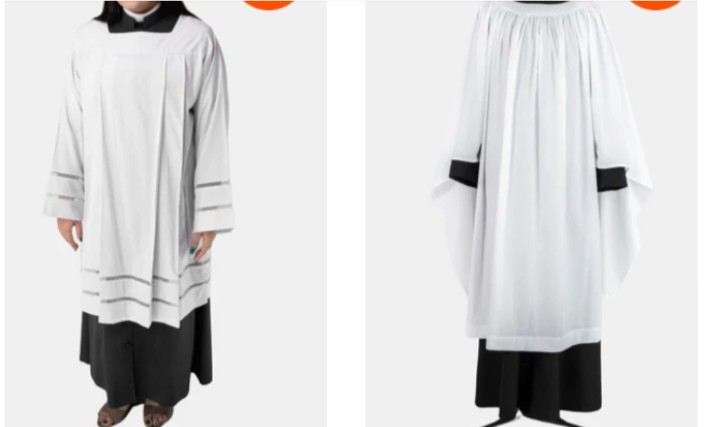
The Anglican Church has a long and rich history filled with traditions, rituals, and garments that have evolved over centuries. Among these, the anglican surplice stands out as one of the most recognizable pieces of liturgical clothing in worship. But how did this simple yet significant garment become so integral to Anglican liturgy? Let’s dive into the history and importance of the surplice, and explore how it continues to play a crucial role in the modern church, including in the attire of female bishops.
The Origins of the Surplice
The surplice, a white, loose-fitting garment with wide sleeves, is worn over a cassock during church services. Its origins date back to the early Middle Ages, around the 11th century. Initially, it was worn by clergy as an outer vestment in colder climates because it provided additional warmth. Over time, the surplice became more than just a practical garment; it evolved into a symbol of purity and the sacred nature of the church’s rituals.
In the Anglican Church, the surplice became particularly important during the Reformation in the 16th century. As the Church of England sought to distinguish itself from the Roman Catholic Church, certain liturgical garments were retained, while others were discarded. The surplice, with its simple design and white color, was seen as a fitting garment that emphasized the Reformation’s focus on simplicity and accessibility in worship. Unlike the ornate vestments of the Catholic tradition, the surplice represented a move towards a more straightforward and, some would argue, more authentic form of worship.
The Role of the Surplice in Anglican Worship
The surplice is most commonly worn by clergy during services such as the Eucharist, Morning and Evening Prayer, and other liturgical functions. Its use is not limited to priests; deacons, lay readers, and choristers may also wear it. The white color of the surplice symbolizes purity and serves as a reminder of the spiritual cleanliness that is associated with the act of worship.
One of the reasons the surplice has endured in Anglican liturgy is its versatility. It is a garment that can be worn over a cassock or even a regular clergy shirt, making it suitable for various services and occasions. Its wide sleeves and loose fit allow for ease of movement, which is particularly important during more elaborate ceremonies.
The simplicity of the surplice also allows it to complement other liturgical garments. For example, it can be worn under a stole, which is a narrow strip of cloth draped around the shoulders and used to signify different liturgical roles. The combination of these garments helps to create a visually cohesive appearance that is both dignified and appropriate for the solemnity of church services.
The Significance of the Female Bishop’s Chimere
As the role of women in the Anglican Church has evolved, so too has the attire worn by female clergy. One of the most notable garments worn by female bishops is the chimere, a sleeveless, open-front robe that is traditionally worn over a rochet (a white, ankle-length garment). The chimere is often made of black or red material and is usually fastened with a simple band at the front.
For female bishops, the chimere holds significant meaning. It is a garment that symbolizes authority and the spiritual leadership of the bishop within the Anglican Church. When worn over the surplice, the chimere not only adds to the bishop’s overall appearance but also reinforces the connection between the traditional and the contemporary roles of women in the church.
The chimere, like the surplice, is a garment with a long history. Originally worn by both male and female clergy, it has now become a distinctive part of the vestments worn by bishops, particularly in the Anglican tradition. The inclusion of the chimere in the vestments of female bishops reflects the broader acceptance and recognition of women’s leadership roles within the church. It also serves as a visual reminder of the continuity of Anglican tradition, even as the church continues to evolve.
The Evolution of Female Clergy Attire
The introduction of the female bishop chimere is just one example of how the attire of female clergy in the Anglican Church has evolved over time. Historically, the church was a male-dominated institution, and the garments worn by clergy were designed with men in mind. However, as women began to take on more prominent roles within the church, there was a need to adapt these traditional garments to suit the needs and sensibilities of female clergy.
One of the most significant changes in female ordained minister outfit has been the adaptation of the surplice and other liturgical garments to fit women’s bodies. While the traditional surplice was designed to be loose-fitting, it was still based on male proportions. Today, surplices and other liturgical garments are available in sizes and cuts that are specifically tailored for women, ensuring both comfort and appropriateness during worship.
In addition to the surplice, female clergy may also wear other garments such as the cassock, the alb (a long, white tunic), and the stole. Each of these garments serves a specific purpose within the liturgy and helps to create a sense of reverence and solemnity during church services. The availability of these garments in styles that suit women is a testament to the Anglican Church’s commitment to inclusivity and the recognition of the important role that women play in the church.
The Surplice and Modern Anglican Worship
Despite the many changes in the church and society over the centuries, the surplice has remained a staple of Anglican liturgy. Its enduring presence is a testament to its significance within the church, as well as its ability to adapt to changing times. Today, the surplice is worn by clergy of all genders during a wide range of services, from the most formal Eucharist to the more intimate Morning and Evening Prayer.
In modern Anglican worship, the surplice continues to serve as a symbol of purity, simplicity, and reverence. Its white color and simple design help to create a sense of sacredness during worship, drawing attention away from the individual and towards the act of worship itself. The surplice also serves as a reminder of the long history of the Anglican Church and its commitment to maintaining the traditions and rituals that have shaped its identity.
The continued use of the surplice in Anglican worship also speaks to the importance of continuity within the church. While the Anglican Church has embraced many changes over the centuries, including the ordination of women and the inclusion of female bishops, it has also sought to maintain a sense of connection to its past. The surplice, with its roots in medieval Europe and its enduring presence in modern worship, serves as a tangible link between the church’s past and its future.
The Role of the Female Bishop Chimere in Contemporary Anglicanism
As more women take on leadership roles within the Anglican Church, the role of the female bishop chimere has become increasingly important. This garment, which is traditionally worn by bishops during formal services, serves as a symbol of the authority and spiritual leadership of the bishop. For female bishops, the chimere is a powerful reminder of the progress that has been made in the church, as well as the challenges that still lie ahead.
The female bishop chimere is often worn over a surplice, creating a striking visual contrast between the white of the surplice and the darker color of the chimere. This combination of garments serves to highlight the bishop’s role within the church, while also reinforcing the continuity of Anglican tradition. The chimere, with its rich history and symbolic significance, is an important part of the vestments worn by female bishops, and it plays a crucial role in the liturgical life of the Anglican Church.
As the Anglican Church continues to evolve, the role of the female bishop chimere will likely continue to grow in importance. This garment, which represents both tradition and progress, is a powerful symbol of the changing role of women in the church. By wearing the chimere, female bishops not only affirm their place within the Anglican hierarchy, but also contribute to the ongoing development of the church’s liturgical traditions.
Summing Up:
In conclusion, the surplice has become a staple of Anglican liturgy due to its simplicity, symbolism, and versatility. As the Anglican Church continues to evolve, so too does the attire worn by its clergy, including the female bishop chimere. Whether you are a clergy member in need of new vestments or simply interested in learning more about the rich traditions of the Anglican Church, eClergys is a valuable resource for all your clergy attire needs.


